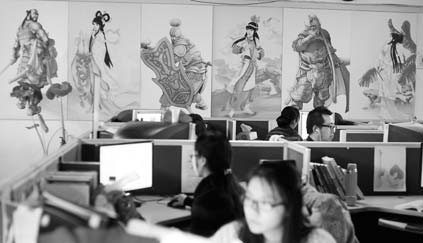Drawing-room sensation
Updated: 2013-05-19 07:50
By Yang Yang(China Daily)
|
|||||||
|
Chen Weidong's comic book Romance of the Three Kingdoms earned him fame and cash. Photos by Jia Lei / for China Daily |
|
Artists at Chen's studio share his passion for fantasy animation images. |
A meeting over tea in Tianjin turned classic comic-book capers into a serious business, Yang Yang discovers.
It was an hour that changed Chen Weidong's life - and the fate of China's comics industry.
One day late in 2005, a man from South Korea came to a three-story house in the Nankai district of Tianjin, where Chen, a struggling comic-book artist, had his office.
Opening the dirty glass door, the visitor saw an excited group of people playing mahjong, and on the other side of the stairs a small convenience shop. He squeezed his way up to the second floor, where he sat down at a table on which Chen started to make tea in the traditional intricate fashion.
Han Jung-rok, the president of Cambridge Co Ltd, a publisher of English books in Seoul, was very interested in Chinese culture. He had met Chen years earlier and the two became good friends. But this time, he came to do business.
Chen, then 36, and his Tianjin Creator World Comic Company were in a crisis. The creative team led by Chen had been engaged in a huge project: adapting China's four great classical novels - A Dream of Red Mansions, Journey to the West, Romance of the Three Kingdoms and The Water Margin - into comic books.
"We wanted to do something different, something brilliant that could not be surpassed for three decades, so in this once-in-a-lifetime project we did a large amount of research and tried to apply traditional Chinese painting techniques, such as those in gongbi painting ("meticulous" realist style) to comic creation," Chen says, sitting and making tea in the tea room on the ground floor, surrounded by shelves packed with hundreds of comic books and periodicals.
The project started in 2002 and by 2005 Chen and his team had finished Journey to the West and The Water Margin. The project consumed so much time and money that at the end of 2005 it seemed impossible to continue. Chen planned to create 30 books for each novel, 120 in all - a massive undertaking for any Chinese publisher at that time.
Then there was the marketing challenge: The four classic novels were already so familiar in China, what parent would pay several hundred yuan to buy them as picture books for their children? The kids already knew the stories.
Chen, however, believed they would appeal to non-Chinese speakers and to people from other cultures who wanted to know about the country's classic literature. The comic books could prove a good introduction, with vivid drawings presenting details of ancient Chinese clothing, hairstyle, decorum, architecture and customs.
It was exactly what Han believed too.
Han's visit saved the project. He negotiated with Chen for an hour and then bought the international dealership of the four collections for 10 million yuan ($1.6 million).
It was a big deal at a time when Japanese comics dominated the Asian market.
To date, the comic books of Journey to the West and Romance of the Three Kingdoms have been sold in 17 versions to countries and regions including South Korea, Japan, Spain, the UK, France, the US, Thailand and Vietnam.
Japan was one of the most difficult markets to enter because it has its own highly developed comics industry. Japanese comic books also account for 40 percent of the European market and 20 percent of the US, Chen says.
So it was almost a superheroic act when, in 2006, The Water Margin became the first Chinese original comic book to enter the Japanese market.
And back home the same year, the black-and-white Japanese comic style, which had dominated the Chinese market for decades, met its colorful match when Chen cooperated with China's largest periodical publisher, Zhiyin Group, to launch a comic weekly called Zhiyinmanke in his "New Chinese Comic Style".
The weekly proved very successful and now the new style dominates the domestic market.
Chen was born and grew up in a remote city in Northwestern China's Xinjiang Uygur autonomous region. His parents had been among those sent from the cities to the countryside during the "cultural revolution" (1966-76).
He went on to study oil painting at Hangzhou Normal University.
After graduating, he went to Beijing, joining a group of young painters at the Old Summer Palace, who lived meagerly off the sale of their art.
In 1995 Chen landed a design job at an advertising company in Tianjin. But what he always wanted to do was to create comics. He left the company a year later and started his own studio, Creator World Comic.
Since that meeting with Han, his Korean publisher friend, the success of the four Chinese classic comic-book series has brought Chen fame and wealth.
Chen's studio too has developed into a business group that incorporates a creative branch, copyright company and website service.
"For years, most of China's cartoonists have been starving," says Chen, now 44. "They earn very little from their drawing - 200 to 300 yuan for a page. Even if they become popular, there will be many copycats right away. That is what I'm trying to change through our group."
And, comic illustrators across the country are being inspired by his story and dreaming of emulating his success.
Contact the writer at yangyangs@chinadaily.com.cn.
(China Daily 05/19/2013 page4)

